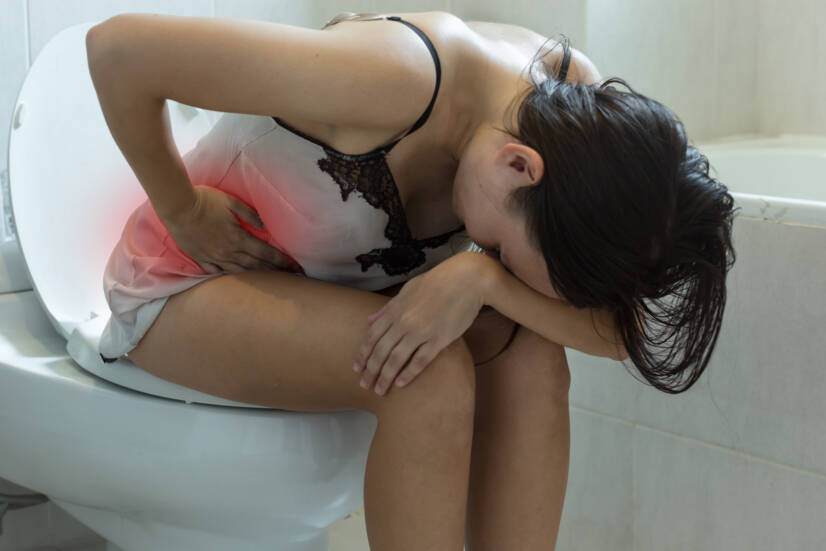- wikiskripta.eu - Meteorism
- gastroenterolog.com - Abdominal bloating, distension, flatulence. Jozef Klucho, MD
- mayoclinic.org - Intestinal gas
- Colins Douglas, R.: Differential diagnosis of first contact. Translation of the 3rd,completely revised and expanded edition.
Windstorms: a problem for adults, children and pregnant women?

Abdominal pain, bloating, discomfort in the lower abdomen are also a signal of stuck winds.
Article content
However, we are not very successful in doing so.
What are winds?
Winds (flatus) are also popularly known as farts. They are a mixture of gases formed in the intestine, usually with an unpleasant smell. They are expelled through the rectum. Professionally, this phenomenon is called flatulence. If the final stage (the release of wind) does not come, pain occurs. This phenomenon is called as stuck winds.
Composition of winds:
- 59% nitrogen
- 21% hydrogen
- 9% carbon dioxide
- 7% methane
- 4 % oxygen
This mixture is flammable due to its hydrogen and methane content.
The smell of the gas is due to the sulphane, which contains sulphur.
The temperature of the gas before release is approximately the same as the body temperature.
The average escape velocity of the gas is 3 m/s.
It is important to note that stagnant winds are not the primary problem. Excessive accumulation of gas in the intestine or even retention of gas causes stagnant winds.
Obstructed winds in pregnancy
Excessive gassy winds in pregnancy are mainly caused by increased levels of progesterone in the body of a pregnant woman.
This hormone causes the intestinal wall to sag, resulting in slower movement of food in the intestines.
Bloating usually worsens in the 3rd trimester of pregnancy when the uterus is large and presses on the stomach.
An insignificant factor to consider for many women is the limited movement in the high stage of pregnancy.
Flatulence and bloating are natural phenomena in pregnancy and in principle are not dangerous for the mother or the developing fetus.
The exception is when certain other risk symptoms appear.
With prolonged bloating and flatulence, there may be feelings of pressure or mild pain or cramps in the lower abdomen.
However, if these are more intense symptoms that persist for a longer period of time, beware.
The most important thing is to avoid constipation. It is constipation that causes excessive gas formation and its subsequent constipation.
It is also recommended:
- Adjust your diet during the day - eat smaller portions of food (more often), eat and chew slowly. This will reduce swallowing of air.
- Eat mainly pulpy fruits and vegetables, probiotic drinks or low-fat yoghurt are suitable.
- Lean chicken or turkey, rabbit (all meaty foods must be sufficiently cooked).
- Beans, peas and lentils in particular should be excluded from the diet, but also plums, pears, white and sour bread or cabbage.
In most cases, you can get by without medical help, but sometimes symptoms such as:
- Intense cramps and pain.
- Hardening of the abdomen
- Blood in the stool
- Prolonged constipation
In this case, do not hesitate to contact your doctor!
You often ask:
Which foods and drinks do not cause excessive flatulence?
Answer:
Eat foods that can modify both the flatulence and peristalsis itself and the intestinal microflora:
- Tomatoes
- Cucumbers
- Potatoes
- Lean meats
- Yoghurts with live cultures
- Wholemeal pastries
- Rice
- Acidophilus milk
- Low-fat yoghurts
- Oranges
- Unsweetened and unsweetened beverages
Medication
Common bloating or flatulence can be resolved at home without major complications.
The important thing is to have:
- Regular exercise within your ability and capacity - small daily walks are ideal (this will encourage intestinal peristalsis).
- The possibility of treatment with over-the-counter products - a pregnant woman should always consult a doctor about their use.
- Compliance with previous dietary recommendations.
Does it affect men or women more?
The basic fact is that the formation of gases is perfectly natural. The problem arises when these gases accumulate excessively and cause bloating of the abdomen or when the outflow of winds stops altogether.
The peculiarity is that gas (bloating) affects mainly women. In them the feeling of a distended abdomen is much more common than in men.
It can occur before menstruation, when most women experience a bloated, tense abdomen and associated flatulence.
Meteorism is related to water retention in the body, which is more pronounced in women than in men.
Interesting.
Diseases of which flatulence is a symptom
Diseases in which flatulence is the dominant symptom may arise from the upper and lower digestive system, the gallbladder and biliary tract, and also the pancreas.
They can be divided into organic and functional.
Table of organic and functional disorders of the lower digestive tract
| Organic | Functional |
| Partial intestinal obstruction | Irritable bowel syndrome |
| Total ileus | Functional disorders of the rectum |
| Tumors | Defecation disorders |
| Bowel motility disorders |
All the diseases listed in the table are accompanied by excessive gas production, which can lead to their complete cessation.
Excessive food intake causing bloating, frequent swallowing of air while eating or talking should be ruled out. When problems with gas accumulation do not subside, pain, cramps or problems with stool elimination come, it is necessary to see a doctor.
Diagnosis
- Taking a medical history - A thorough interview with a doctor to clarify current and previous problems.
- Medical examination - The doctor palpates the abdomen.
Using a phonendoscope, auscultates (listens) for the presence/absence of peristalsis. - Laboratory examination - Basic set of blood tests according to the doctor's office + special tests to detect possible chronic hepatitis (inflammation of the liver), pancreatitis (inflammation of the pancreas), cholecystolithiasis (inflammation of the bile ducts and possible presence of a stone).
- Imaging methods - Using USG (ultrasound), X-ray, or MRI (magnetic resonance imaging) or CT (computed tomography) imaging, it is possible to detect and determine the levels of gas in the intestines.
- Examination by a specialist doctor - After consideration by the GP, the patient may be referred for further examination to a specialist gastroenterologist who will carry out further special tests.
Other appropriate investigations include:
- stool examination for occult (hidden) bleeding
- stool examination for parasites
- examination for histamine intolerance
- lactose tolerance test
- gastroscopy
- colonoscopy
Treatment
There is no direct treatment for a stuck wind. The important factor is always the disease that accompanies the stuck wind. Depending on the diagnosis and the final diagnosis, the doctor will determine the appropriate treatment.
The most common cases are:
- Regimen measures - Lifestyle change.
- Medication - The doctor will prescribe appropriate medication according to the patient's needs and condition.
- Surgical - For serious life-threatening conditions, surgical treatment is indicated (ileus conditions).
Infected winds in newborns
So-called neonatal colic presents a stressful situation for parents, forcing them to make frequent visits to the pediatrician. It is believed that the symptoms are related to abnormalities of the intestines or other parts of the digestive system.
What is colic?
A certain type of behaviour in a child characterised by bouts of prolonged inconsolable crying and restlessness with no apparent cause. It occurs predominantly in the first three months of life.
Seizures most often occur in the afternoon or evening and are not caused by hunger or unmet biological needs of the newborn. Statistically, they occur more often in boys and in children whose sibling also suffered from colic in infancy.
You often ask:
What causes colic?
Answer:
The cause of colic is still unclear. It occurs in fully breastfed babies, but also with artificial nutrition. It is believed that the cause is the wrong way of feeding and possibly swallowing air. If the baby does not burp enough, the air gets into the stomach, where it later causes pressure on the intestine. This can trigger symptoms.
However, these are still just assumptions.
The cause of the occurrence in the late afternoon and evening is not clear. It is not related to the socio-economic background or the health of the parents.
It is believed that gastroesophageal reflux, overfeeding or, on the contrary, inadequate nutrition, food allergy (allergy to cow's milk) are involved in the development of neonatal colic.
Symptoms of colic:
- Seizures of huge crying.
- Crying is different from normal crying when needing to eat or change diapers.
- The baby is clenched, his hands are clenched into fists, he is stiff, pressing his little legs to his tummy.
- There are problems with defecation.
- Seizures come on suddenly and subside abruptly.
- They occur most often in the afternoon and evening.
- They are not related to eating and the need to change clothes.
- Examination of the child shows no abnormalities, the child is eating normally and thriving.
- If he is not thriving, colic in combination with another disease is possible.
Diagnosis in newborns
The diagnosis of colic in newborns can only be made after excluding many other diseases with these symptoms.
The paediatrician will decide on the necessary examinations. Gastroesophageal reflux and allergy to cow's milk should be ruled out.
Anomalies and diseases of the digestive tract should also be ruled out. Also lactose intolerance.
What is the treatment in the neonatal period?
Special treatment is not carried out. However, by preventive measures and supportive treatment, we can alleviate the symptoms.
Regimen measures are important:
- Early feeding of the infant. This will eliminate the fussiness of the infant and also the gnawing of food when very hungry.
- Timely changing of baby's diaper. Adjustment of environmental conditions (suitable temperature).
- Never shake or throw the baby on your hands, do not make sudden movements, for example when changing or bathing.
- Clockwise massage of the tummy and warm compresses, exercises with the feet are helpful. This will facilitate the passage of gas and stool.
- Modification of the mother's diet in breastfed babies. It is necessary to exclude foods that cause flatulence.
- The position of the baby is important (the "airplane" position, legs bent).

Are pregnant women particularly affected by constipated winds?
The answer is: NO!
No. Infected winds affect everyone at least once in their lifetime, regardless of age, gender and any illnesses we may have.
And that's why...
The most important thing is to prevent excessive winds and then stop them.
If you're often plagued by bloating or stuck winds, it's time to think about a lifestyle change.
- Give yourself plenty of time to eat - chew slowly to limit the large intake of air and help your digestion.
- Limit (or if intolerant, completely eliminate) foods containing indigestible sugars.
- Eliminate smoking, chewing gum, drinking carbonated beverages.
- Eat less and more often. Try to divide your meals into several portions a day.
- Make a diet plan - by keeping a systematic diary, find out which foods do not suit you. Cut them out of your diet.
Movement is an important factor.
Walking, light sporting activity or even working in the garden helps the wind to leave more easily and is in itself a good prevention of congestion.
Herbs can also help:
- Peppermint
- Yarrow
- Ginger (in small amounts)
- Fennel
Interesting resources










